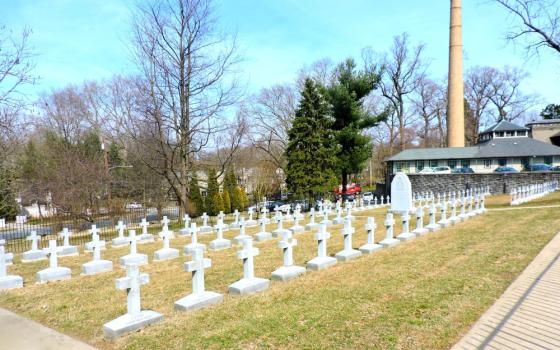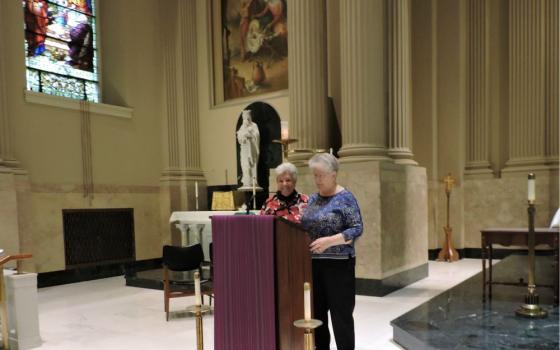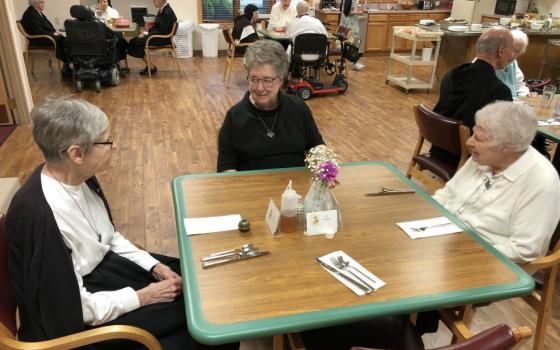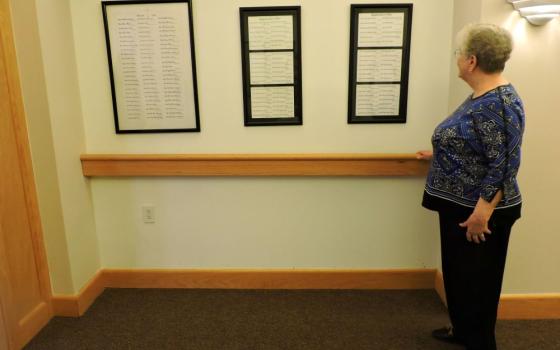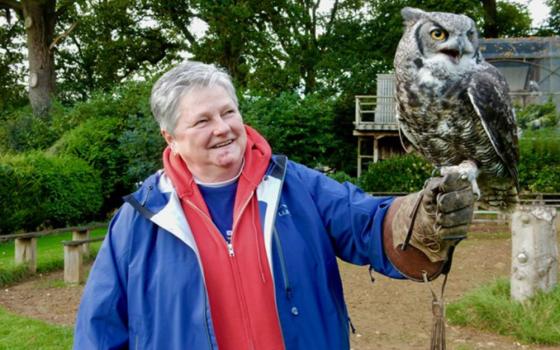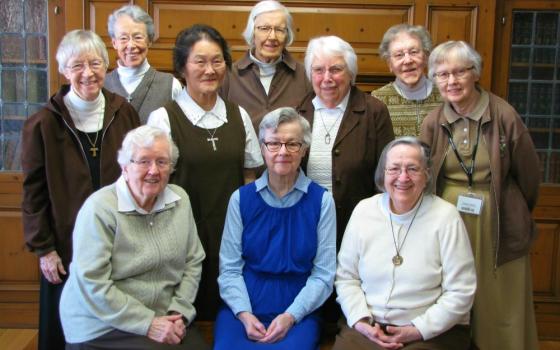Editor's note: The declining numbers of Catholic sisters in America will come as no surprise to GSR readers. But every loss is significant in itself. In Part 1 of "A Good Death," a two-part series, we ask sisters how their communities address the death of a member. Part 2 profiles two sisters who face the possibility of death as a daily reality.
______
When Rose Pacatte, who is a Daughter of St. Paul, gets on an airplane wearing her habit, "people think, 'We will be great,' " she said, suggesting that passengers think having a sister aboard may be a guarantee of a safe arrival. "Don't be too sure," she tells them. "When the time comes, it's our time," she added, recalling one instance in which she took out her rosary while in flight, and a woman asked her, "Are you serious?"
In her matter-of-fact approach, confidence in a divine plan and puckish but down-to-earth sense of humor, Pacatte resembles the other sisters interviewed for this story — not longing to slip the bonds of Earth permanently but ready for any eventuality.
"It's not something we fear. Dying well is just part of our lives," says the nun, the founding director of the Pauline Center for Media Studies in Los Angeles.
That's a realistic approach, both for individuals and for communities.
Given that 77 percent of women religious are older than 70, decline and death are realities that communities have been, and will be, confronting for decades.*
Some groups of women religious encourage sisters to plan their own funerals, down to the prayers and the hymns that they want included. Others take a more communal approach, enlisting friends and family members in planning the event.
Some are buried in convent cemeteries, others in Catholic ones. Some choose an ecologically sensitive green burial or to be cremated.
But interviews with sisters in a variety of communities suggest that many bring a bracingly practical, even matter-of-fact approach to preparing for the inevitable.
"Women religious are pretty good at planning for our future," said Mercy Sr. Marie Michele Donnelly in Merion, Pennsylvania. "We project the demographics, we know how our investments will support us, we restructure so that death doesn't come as a surprise or the future as an accident."
And they know what they don't know, she said. When they don't have a skill (say, if a community lacks a sister with financial planning chops), they invite an expert in to advise them.
It's become clearer over the past few decades that religious communities, both male and female, have an undeniable need to address the gritty realities of illness and death. As the Center for Applied Research in the Apostolate documents over time, religious communities of women are shrinking.
"With the current trend of aging membership and declining vocations, approximately 300 religious institutes in the United States are at some stage of transition with some in their final generation of historical existence," said Mercy Sr. Sharon Euart, executive director of the Resource Center for Religious Institutes, in an email message. Most institutes are planning for transition by "combining provinces, consolidating institutions, addressing retirement needs, and studying options for canonical governance," she said.
It's challenging enough to face the reality of one's own imminent death or the loss of a lifelong friend. (Many sisters in religious communities entered in the pre-Vatican II days, right out of high school.) But religious orders are also experiencing loss, both of individual sisters and of entire communities.
In a GSR commentary, Sinsinawa Dominican Sr. Christin Tomy noted that her community has buried 10 colleagues in the past year.
"The hardest thing for me as a sister was when three of our sisters died within four days," said Benedictine Sr. Cathleen Marie Timberlake, who serves as "sister administrator" at the monastery health care center. From 2015 to 2018, they lost 18 sisters, she recalled.
But as the sisters recounted the details that accompany the end of life in their communities, one common thread appeared again and again: Sisters are accompanied on this last journey.
Or, as Donnelly put it: "Because of the support of our community, we rarely die alone."
Many sisters now in their 70s and older entered in their teens at a time when membership was surging.
Though the American branch of Pacatte's order was founded in 1932, she says a sister did not die until 1978 — in the middle of a blizzard. At the time, they had no burial chapel or mausoleum, and the undertaker had to house her body until the ground had thawed enough to bury her, said Pacatte.
In past years, she said, when the end was coming, others would go into a sister's room and pray the rosary. Loudly, without ceasing.
Times have changed, she said — and that's good. "God help them if anyone does that when I am dying. I would shoot them," she says, adding quickly that she has no issue with soft prayers and visitors. "I think our attitude became psychologically healthier."
With approximately 200 convents around the world, the leadership of the Daughters of St. Paul uses the internet to keep local outposts up to date on a sister's condition, she added. When a member of the order dies, the superior general sends out an obituary, complete with photos, and a holy card with the sister's birth and death dates. "It's a wonderful way to get to know our community. We do care."
Six or so months later, they receive a more extensive biography in the form of a pamphlet, said Pacatte, adding that she intends at some point to write a book so that new members will have a connection with their history.
The Sisters of Mercy, the largest women religious institution in the country, has more than 700 sisters in its Mid-Atlantic region. Many of the ones not working in full-time ministry have rooms in a large, gray 19th-century stone residence on Philadelphia's Main Line in Merion, Pennsylvania. A center for the sisters who need ongoing medical care also occupies the property. Behind the imposing convent is the cemetery where sisters affiliated with the Philadelphia area are buried.
Mercy Sr. Kathleen Lyons, 72, has been helping her community organize funeral services for 30 years, routinely consulting with family members and other sisters.
Fran Teti is a member of one of those families. She and her sister Michele were very close to her aunt, Sr. Mary Franceline Marsh, and visited her often at McAuley Convent, the retirement care community that sits next to the Mercy convent. When they were out of state at a family wedding in February, a sister notified them that their aunt had died, saying, "When you come back, let's get together and do the things that would make this a meaningful time for you," recalled Teti.
Teti and her sister were invited to the convent to tell stories — "She had a kind of a feisty personality," she said — and to plan a "send-off" appropriate for an aunt who had meant a great deal not only to her family but to the sisters who had been her companions for many decades.
After a viewing at McAuley, family and sisters processed up to the Mercy convent for vespers and dinner, said Teti. The funeral Mass took place the next day in the chapel. "It was a beautiful time for our family. We appreciate how much the Mercy sisters supported us in every way."
Funerals here begin on the staircase leading to the chapel and include a rotating litany of all the sisters who have preceded them, reaching all the way back to the sisters who traveled from Ireland to found the order in North America.
Lyons recalls, "One time a funeral director said to me, 'The thing I admire most is [that] when a sister dies, each sister is well-celebrated,'" said Lyons. Having experienced the loss of family members early in life, it's important to her that the service is done well, she said.
Donnelly, who has created and taught classes about suffering and death for high school and college students, currently directs bereavement group programs for parish caregivers in the Philadelphia Archdiocese. This past year, at the invitation of another sister, she put her expertise to work closer to home, facilitating a program for sisters residing in the Merion convent.
She found, she said, that many were experiencing loss not directly related to imminent death, whether it was the loss of sight, hearing or the opportunity to be of service (which is the fourth vow the Mercy Sisters take). "It's a question of identity: If this is who I say I am, and I can no longer do that anymore, then who am I?"
For sisters facing the end of life, many resources are available, Donnelly said. They include prayer service, sacraments and the presence of other sisters keeping vigil in prayer and song ("no singing for me," she added). In fact, she and other Merion sisters are preparing liturgical resources to assist sisters in other parts of the Mid-Atlantic region who are working with dying community members.
Timberlake, who will celebrate the 50th anniversary of her first vows next year, is the administrator for the health care center for her contemplative community, the Benedictine Sisters of Perpetual Adoration, in Clyde, Missouri.
In the Benedictine tradition, she says, they are advised to "keep death daily before our eyes."
"We have always had a more positive take on death," she said. Sisters often look forward to it and try to live in such a way so that they are more assured of heaven.
When a sister appears to be close to death, she said, members of their community sign up for a vigil in the chapel. "They take the privilege of signing up every bit as seriously as they do adoration," she said.
When a sister dies (and she can choose to be cremated), the sisters process to their chapel and share memories laced with laughter, often in the company of the late sister's family, she said. A monastery workman normally digs a grave, though one of the sisters has dug quite a few, confided Timberlake.
Then the late sister is interred; her coffin, sprinkled with holy water, having been simply crafted by the Conception Abbey Benedictine monks down the road, she said.
In Rochester, Minnesota, the Poor Clare Sisters, having given up their Bloomington monastery last year, now live on a corridor of the Franciscan Sisters of Rochester, once used as dormitory space, said community member Sr. Helen Weier.
"We are basically living a life of retirement," said Weier one of 10 remaining Poor Clare Sisters of Bloomington. Unlike many communities, these contemplatives have only experienced the death of two sisters, one at 102 in 2016 and one at 92 this past January, she said.
The Poor Clares have integrated death into the cycle of their liturgical celebrations. They celebrate the lives of founders Sts. Francis and Clare on their feast days by commemorating their "transitus" through death to new life, said Weier. The deaths of the two saints are marked with psalms, songs and reflective silence, and the services are attended by friends and Third Order associates.
"We do it every year," she said. "It's a very precious celebration for us."
"It's basically the Christian approach to death," said Weier. "Life is changed, not taken away."
Each sister has her own "transitus" file, said Weier, adding that they are comprehensive and include major items like advance health directives and that modern necessity, email passwords.
"I even have my own music copied," said the 86-year-old. "I am a musician and that's important. I want them to know what fired my life." While she doesn't know if her wishes will be honored, Weier added with a touch of classic dry sisterly humor, "I don't think I will care very much when I'm taken off."
Though she's had decades of experience working with parishioners suffering loss, Sr. Fran Donnelly still has a somewhat unusual job: director of life transitions for Catholic Cemeteries in Mendota Heights, Minnesota. "The mission of burying the dead is really a ministry," says Donnelly, a member of the Sisters of Charity of the Blessed Virgin Mary who has helped her own community start the practice of "green" burial that avoids embalming and cremation.
In addition to working with parish staff and lay pastoral and liturgical ministers, Donnelly also helps local orders that may not have cemeteries of their own — or have run out of room to inter their members. Part of her work is partnering with office staff to make sure they have accurate records, which date back to the 19th century. "With so few of the communities here having their own cemeteries, the vast majority are in our cemetery," she explained.
One local order, she estimates, may bury two to three sisters a month. In her own community, which has also lost many sisters, the ones on the Dubuque, Iowa, campus "have to live with the daily reality of death. For the rest of us, it's like reading obituaries all the time."
Those sisters who can't be present for a funeral service can stream it online, she said, and read stories that illuminate an individual sister's life. The reminiscences from a friend "are always the most poignant for me," she added, saying she thinks, "Oh, what a faithful woman she was."
Then she added impishly, "They are never going to say that about me."
But the faith that has shaped a sister's life is central to the way she dies, said Donnelly, mentioning her confidence in the paschal mystery of death and resurrection and the importance of the sacramental offices that have been a part of her life for decades. "While "death is a big moment, it doesn't end there. Our lives' journeys end in resurrection. Death never has the last word."
Read Part 2: Two sisters discover unique gift deep within their suffering
*An earlier version of this story gave an incorrect statistic about religious institutes in the United States and misidentified a sister in two photos.
[Elizabeth Eisenstadt Evans is a freelance writer on the religion beat in the Philadelphia area.]
